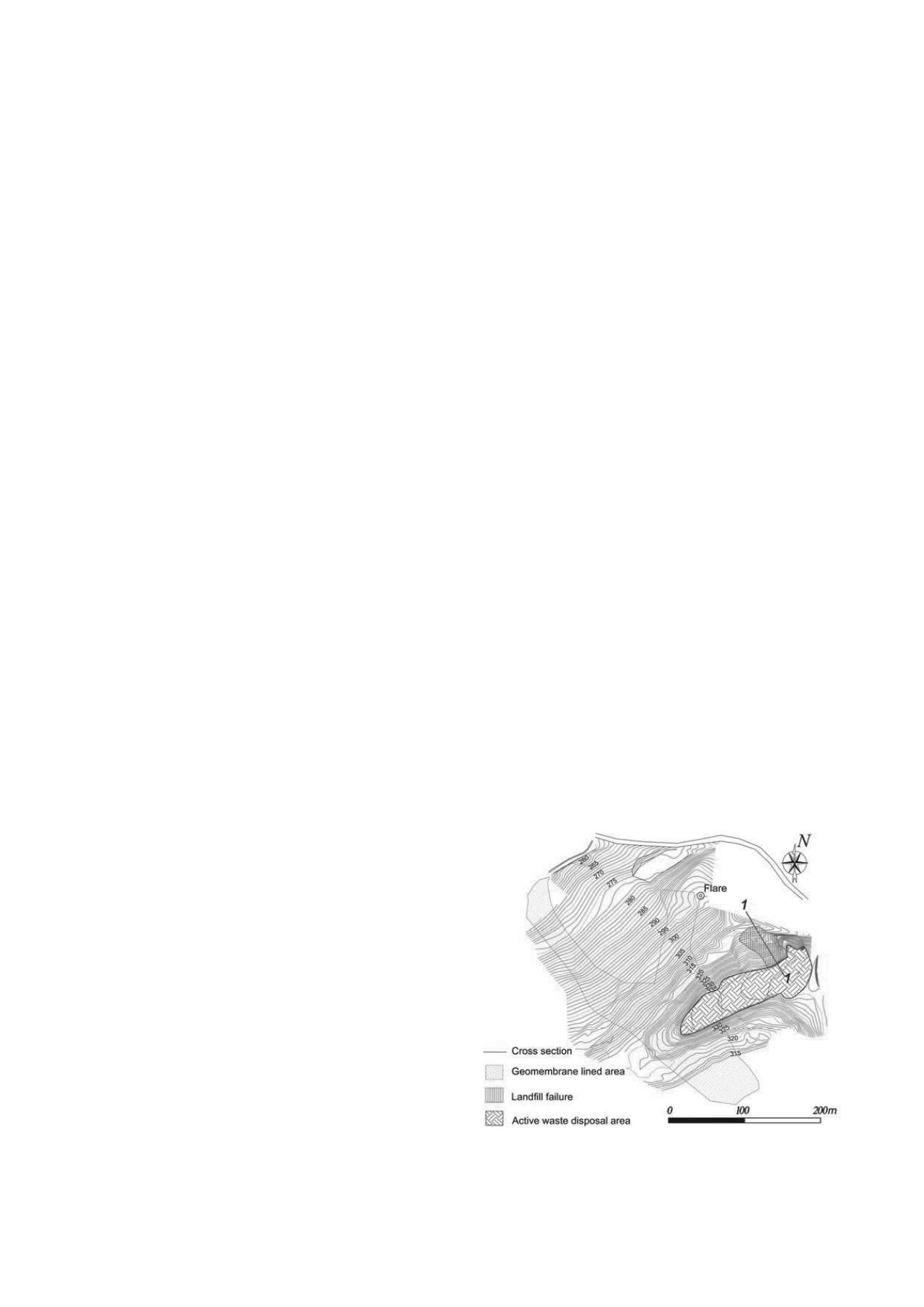
309
Proceedings of the 18
th
International Conference on Soil Mechanics and Geotechnical Engineering, Paris 2013
1
The December 29
th
2010 Xerolakka Municipal Solid Waste landfill failure
29 décembre 2010 : l'échec d'enfouissement Xerolakka
Athanasopoulos G., Vlachakis V.
Dept. of Civil Engineering, University of Patras, Greece
Zekkos D.
Dept. of Civil and Environmental Engineering, University of Michigan, Ann Arbor, USA
Spiliotopoulos G.
Patras Municipality, Greece
ABSTRACT: On December 29th 2010, a 30 m high slope failed at the Xerolakka Municipal Solid Waste landfill in Greece. The
failure resulted in temporary interruption of the landfill disposal activities and closure of the landfill access road; it also received
significant media attention. A reconnaissance of the landfill slope instability was performed a few hours after the failure. Subsequent
data collection, field investigations and numerical analyses were performed to better characterize the causes of the instability. Data
collection included review of available data regarding the landfill design and the waste material at the Xerolakka landfill. Field
investigations included Lidar surveying to closely map the post-failure geometry, as well as shear wave velocity measurements that
were used as a basis for characterization of the MSW material and comparison with data available in the literature. Numerical
analyses included limit equilibrium as well as finite element analyses. The results of the investigation indicate that the failure was
caused by a combination of factors, including, inappropriate waste disposal practices, inadequate compaction, leachate and gas
pressure generation and increased steepening of the landfill slopes.
RÉSUMÉ: Le 29 décembre 2010, une pente de 30 m de haut a échoué à la mise en décharge des déchets Xerolakka solides
municipaux en Grèce. L'échec a entraîné une interruption temporaire des activités de mise en décharge et la fermeture de la route
d’accès à la zone d'enfouissement et d'élimination ont reçu une attention médiatique importante. Une reconnaissance de l'instabilité de
la pente d'enfouissement a été réalisée quelques heures après l’échec. Après la collecte des données, enquêtes sur le terrain et des
analyses numériques ont été réalisées afin de mieux caractériser les causes de l'instabilité. La collecte des données comprenait un
examen des données disponibles concernant la conception de la décharge et les déchets à la décharge Xerolakka. Les enquêtes de
terrain inclus Lidar arpentage de près cartographier la géométrie post-rupture, ainsi que les mesures de vitesse de cisaillement d’ondes
qui ont été utilisées comme base pour la caractérisation de la matière MSW et comparaison avec les données disponibles dans la
littérature. Des analyses numériques incluent équilibre limite ainsi que des analyses par éléments finis. Les résultats de l’enquête
indiquent que la panne a été causée par une combinaison de facteurs, y compris, les mauvaises pratiques d’élimination des déchets, le
compactage insuffisant, le lixiviat et la génération de la pression du gaz et l’augmentation accentuation des pistes d'enfouissement.
KEYWORDS: Municipal solid waste, landfill, slope failure, shear wave velocity
1 INTRODUCTION
To protect public health and the environment, Municipal Solid
Waste (MSW) landfill slopes need to be stable. Unfortunately,
numerous landfill slope failures have been documented in the
literature (e.g. Eid et al. 2000, Hendron et al. 1999, Kavazanjian
and Merry 2005, Huvaj-Sarihan and Stark 2008) and many
more remain undocumented. Although such failures are
undesirable, it is important to learn from them so that similar
occurrences are avoided in the future.
This paper presents the field observations from a
reconnaissance study performed within hours after the
December 29th 2010 Xerolakka landfill slope failure, as well as
subsequent field measurements and stability analyses that were
executed to better understand the causes of the failure.
2 THE XEROLAKKA LANDFILL
The Xerolakka landfill is one of the nine MSW landfills in the
Region of Western Greece, located 5 km east of the City of
Patras. It is a canyon landfill at the foothills of the Panachaikon
Mountain. It started receiving waste in September 1993 and
presently receives 300 tn of waste daily (Sufalnet, 2006).
The site is located on a geologic sequence of Pleistocene and
Pliocene claystone, marls and siltstones with lenses of
sandstones that are generally considered intact. The
groundwater table fluctuates seasonally significantly.
Figure 1. February 2011 topographic map of the Xerolakka canyon
landfill.


